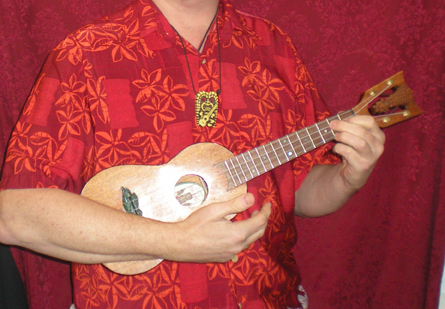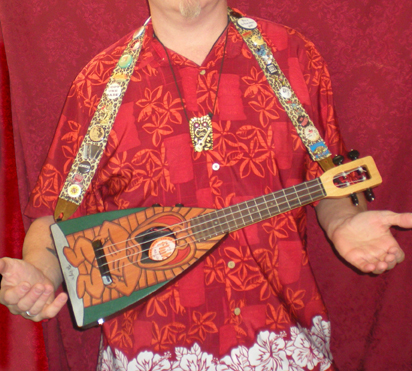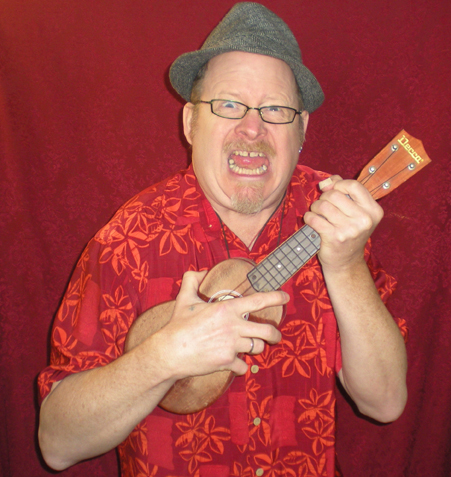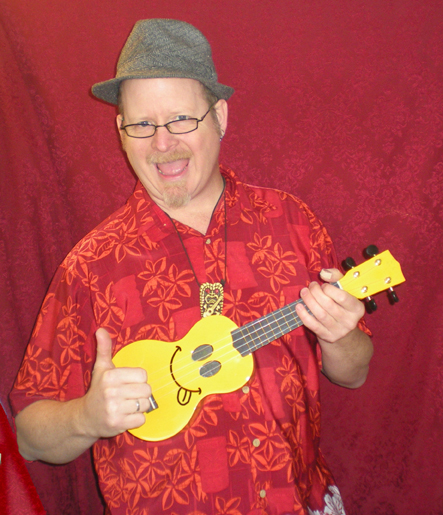Tiki Kings Ukulele Lesson
So, you want to play the Ukulele?. Ok. First lets take a look at the Uke and learn the parts so that we will both be talking about the same things. Here is a Picture that names all the parts and pieces of your new Ukulele.
There are several different types and tunings of Ukuleles, and this lesson will work with any ukulele tuned GCEA, ( we will get to tuning in a minute...) but here is a list of the most common types of ukuleles and there specifics:
Soprano.
(also called "Standard") Approx 21" over all length, with a nut to saddle length of Approx 13 3/4" Generally 12 frets, and is usually tuned in G C E A, ( "C" or "Re-entraint" Tuning) or A D F# B ("D" or "Vaudville" Tuning)
Concert.
Approx 23" over all length, with a nut to saddle length of Approx 15" Generally 15 frets. Usually tuned in G C E A, ( "C" or "Re-entraint" Tuning) But strings are available for other tunings such as "low G", or D G B E ("G" Tuning)
Tenor.
Approx 26" over all length, with a nut to saddle length of Approx 17" Generally 18 frets. Usually tuned in G C E A, ( "C" or "Re-entraint" Tuning) But special strings are available for other tunings such as "low G", or D G B E ("G" Tuning)
Baritone.
The biggest of the Ukulele family. Approx 30" over all length, with a nut to saddle length of Approx 20". Generally 20 frets. Usually tuned the same as the first four strings of a guitar, D G B E. ("G" Tuning) But special strings are available for other tunings such as C C E A
Tiple.(pronounced Tip- Lay or Tee-Play)
A Ukulele type instrument with 10 strings. 2 A's, 3 D's, 3 F's, and 2 B's, with the 2nd A, D, and F tuned an octave down.
Taro patch
An eight stringed Ukulele with four sets of two strings, tuned like a soprano Ukulele, but with some of the strings an octive apart.
Holding Your ukulele
So first things first. I'm sure you are wondering, How do you hold this thing? Well, start with the neck in your left hand, and cradle the body of the Ukulele in the crook of your right elbow, lightly pressing the body of the ukulele against your chest with your right forearm. Don't try to crush it, just use enough pressure to keep it in place.

And, yes, a Hawaiian shirt and Tiki necklace can be can be helpful in getting the right form
You should be comfortable, and end up with your right (srumming) hand right about where the neck of the ukulele meets the body of the ukulele. Most people find this to work out just fine, but for a little more ease of support, I like to use a strap.

Some people will tell you this is wrong, or this is cheating, but hey, we're rebels anyway, right? wild-eyed, crazy ukulele playing anarchists! No rules man! We are on a one way bus ride to Ukulele Valhalla! We're gonna sing and fight and feast and play ukulele and....and... ok, so I got carried away, but what I was getting at is, strap, no strap. It's up to you.
Um, ok, so where were we? ...ah yes. So there you are holding your Ukulele, all stiff and tight, with white knuckles and sweat on your lip. Your eyes are beginning to shake, bulging from their sockets. Veins are swelling on your forehead...

STOP! Relax, loosen up. This is fun, trust me. You have to be relaxed to really play the ukulele.

Besides, if you are tense, you are going to look one of those robot guys you see on the street corners, or worse, like a Mime. So, yeah, have a good time and reeeelaaaaaxxxxx.....

Ok, wait, no. That's too relaxed...
Next...
Back
I'm in the top 50!


So, you want to play the Ukulele?. Ok. First lets take a look at the Uke and learn the parts so that we will both be talking about the same things. Here is a Picture that names all the parts and pieces of your new Ukulele.
There are several different types and tunings of Ukuleles, and this lesson will work with any ukulele tuned GCEA, ( we will get to tuning in a minute...) but here is a list of the most common types of ukuleles and there specifics:
Soprano.
(also called "Standard") Approx 21" over all length, with a nut to saddle length of Approx 13 3/4" Generally 12 frets, and is usually tuned in G C E A, ( "C" or "Re-entraint" Tuning) or A D F# B ("D" or "Vaudville" Tuning)
Concert.
Approx 23" over all length, with a nut to saddle length of Approx 15" Generally 15 frets. Usually tuned in G C E A, ( "C" or "Re-entraint" Tuning) But strings are available for other tunings such as "low G", or D G B E ("G" Tuning)
Tenor.
Approx 26" over all length, with a nut to saddle length of Approx 17" Generally 18 frets. Usually tuned in G C E A, ( "C" or "Re-entraint" Tuning) But special strings are available for other tunings such as "low G", or D G B E ("G" Tuning)
Baritone.
The biggest of the Ukulele family. Approx 30" over all length, with a nut to saddle length of Approx 20". Generally 20 frets. Usually tuned the same as the first four strings of a guitar, D G B E. ("G" Tuning) But special strings are available for other tunings such as C C E A
Tiple.(pronounced Tip- Lay or Tee-Play)
A Ukulele type instrument with 10 strings. 2 A's, 3 D's, 3 F's, and 2 B's, with the 2nd A, D, and F tuned an octave down.
Taro patch
An eight stringed Ukulele with four sets of two strings, tuned like a soprano Ukulele, but with some of the strings an octive apart.
Holding Your ukulele
So first things first. I'm sure you are wondering, How do you hold this thing? Well, start with the neck in your left hand, and cradle the body of the Ukulele in the crook of your right elbow, lightly pressing the body of the ukulele against your chest with your right forearm. Don't try to crush it, just use enough pressure to keep it in place.

And, yes, a Hawaiian shirt and Tiki necklace can be can be helpful in getting the right form
You should be comfortable, and end up with your right (srumming) hand right about where the neck of the ukulele meets the body of the ukulele. Most people find this to work out just fine, but for a little more ease of support, I like to use a strap.

Some people will tell you this is wrong, or this is cheating, but hey, we're rebels anyway, right? wild-eyed, crazy ukulele playing anarchists! No rules man! We are on a one way bus ride to Ukulele Valhalla! We're gonna sing and fight and feast and play ukulele and....and... ok, so I got carried away, but what I was getting at is, strap, no strap. It's up to you.
Um, ok, so where were we? ...ah yes. So there you are holding your Ukulele, all stiff and tight, with white knuckles and sweat on your lip. Your eyes are beginning to shake, bulging from their sockets. Veins are swelling on your forehead...

STOP! Relax, loosen up. This is fun, trust me. You have to be relaxed to really play the ukulele.

Besides, if you are tense, you are going to look one of those robot guys you see on the street corners, or worse, like a Mime. So, yeah, have a good time and reeeelaaaaaxxxxx.....

Ok, wait, no. That's too relaxed...
Next...
Back
I'm in the top 50!